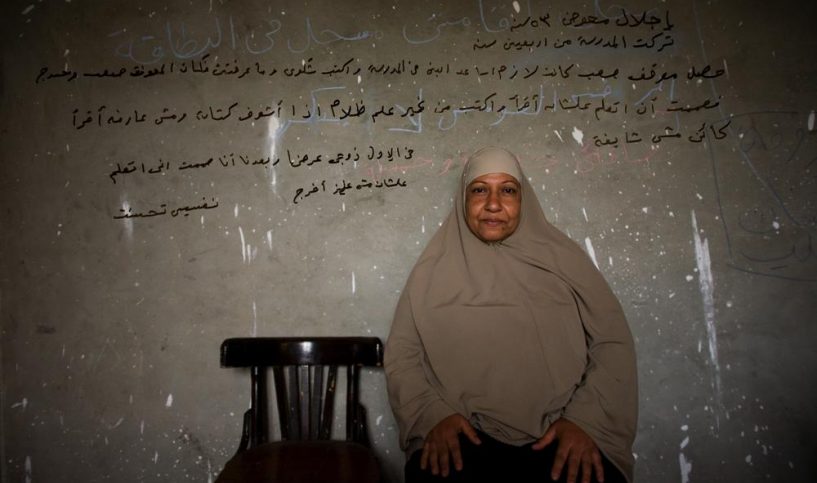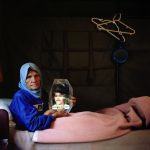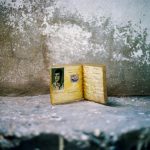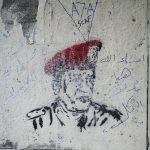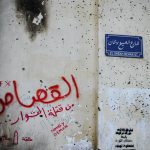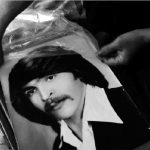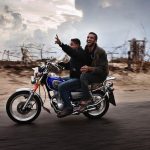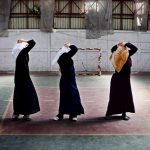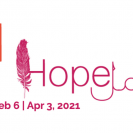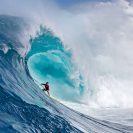by Liane Al Ghusain
The Rawiya photography collective began through a series of informal meetings all over the world in 2009, launching their first official group exhibition in the UK in March 2011. Their name Rawiya means storyteller, and although they do their work independently, the individuals of Rawiya have united around this common identity as women photographers.
Via in-depth photo essays and long-term projects, the Rawiya collective thoughtfully depicts the hardships, contradictions, and ultimately, the poignancies of a region that is in constant flux. It is quite fitting that the following interview was conducted with the members of the Rawiya photography collective via a number of virtual means, including Skype, instant messaging and e-mail.
The individual and group challenges that the six members continue to overcome in creating their collective have been formidable—Myriam Abdelaziz (Egypt), Tamara Abdul Hadi (Jordan), Laura Boushnak (Jordan, Bosnia),Tanya Habjouqa (Palestine), Dalia Khamissy (Lebanon) and Newsha Tavakolian (Iran)–have yet to all physically be in the same place, at the same time. And yet they go on determinedly carrying out the vision of the Rawiya collective, spreading social awareness through photography.
LAG: Why did you choose to be a collective specifically of women photographers? What is special about the way that women in particular tell stories about the world?
Dalia: Women in general, and in the Middle East in particular, are subject to a lot of stereotyped ideas… We wanted to change the way we were seen and show our societies in our own ways, which is why we chose Rawiya to be a female photographers collective. We all tell stories of people we relate to.
Newsha: Rawiya for me is a combination of strength. We are from different countries and all have different ideas and visions, but as a group we can have a louder voice. In Persian, we have a saying, “If one person claps their hands, nobody hears them, but when many join in, the sound will be thunderous.”
LAG: Do you avoid “taboo” places where men and women mix for fear of being censored or do you simply find the spaces of gender division more interesting?
Laura: Not at all. I basically work on provocative issues that raise questions to challenge stereotypes. I never do any self-censorship… as long as I’m sensitive to the subject matter I’m dealing with.
Tanya: I personally have a belief that intent comes through in your approach. Recently while photographing Syrian torture victims who had fled into Jordan, there was an uncomfortable moment for some who took off their shirts to show me their wounds. One remarked shyly “I know this is 3aeb, but I want the world to know.” Approach and intent is everything. Sometimes because we are women I feel we get unique access to situations.
Tamara: Gender division is a given in some societies and I don’t impose my views towards that, rather I try to show it as it is.
Dalia: I have been in places where I had to cover my head or even wear an abaya to be able to enter, to take a picture of a sheikh or an ayatollah, or even to enter a hawza (traditional Islamic school of higher learning). But I never had any problem in doing that and I was always respected in those places and welcomed with a lot of respect and a smile… Maybe because I showed respect when entering the space of others – I think this is the main key.
LAG: How does being in a collective change the way you see the world around you?
Tanya: We are working in a region where the dignity of representation is often contested by stereotypes and agenda. It is empowering coming together on the Rawiya platform as I feel it gives us an “agency” in challenging the status quo of racism and orientalism that can be prevalent in media (mis)representation.
The growth of both great regional artists and photographers along with respected regional news platforms like Al Jazeera is an opportunity to push back. There is a growing interest in photography in the region, in new galleries. We have come a long way…I remember when I started in my early 20s my Jordanian grandmother looking at my portfolio and saying, “Interesting. So why do you do this? And when will you get a real job?” Today, we have young photographers writing us and asking us for advice.
LAG: Who coordinates the Rawiya collective? Are different members responsible for different things?
Myriam: It is a group effort. We do not have a coordinator; instead we share tasks and rotate if necessary. We are all equally participating according to our personal, professional or regional situation.
LAG: How do you inspire each other’s work? Any specific examples or stories about how you have learned from each other?
Myriam: Inspiration is food for creativity, we all need it. I have no specific situation in mind, but for sure just following each other’s work is, in itself, stimulating.
Laura: The fact that we simply exchange ideas and comment on each other’s work has been a great source of inspiration for me.
LAG: The artist and the photojournalist are both observers, but how would you say that the way they observe things is different?
Myriam: Photojournalism has rules, there are ways to tell a story, you need an opening and a closing shot, details and actions shots etc… so you have to tell the story while following the ‘Photojournalist’ way. I find that frustrating so I never call myself a Photojournalist. I want to tell the story the way I saw it, the way I felt it with no rules or boundaries.
Tanya: It is true, there are more “rules” in photojournalism. If I am on an assignment for a news outlet, I have to put on my journalism “chapeau” but try to bring my specific style/nuance to that approach. I take the required opening/closing etc., and if there is time after, take some shots for me as well. (Which sometimes ARE used in a news story). Or I form a relationship with that person and go back and shoot without the journalism chapeau, so I have more time to shoot relaxed, slowly…my favorite approach.
Dalia: Personally I never said I was a photojournalist or an artist. I always use “photographer” to introduce myself. I always feel the work of the artist is more conceptual … it takes more research to [artistically] approach a subject. As for the photojournalist, his work is different; it is a reality he has to convey to the world … it could be a subjective reality, which is always the case, but still something he has seen with his own eyes that he has to document.
LAG: When did you make the shift from documentary photography to art photography? Do the two continue to overlap?
Myriam: I don’t like categories: photojournalist, documentary photographer, artist, etc., all these are categories that limit you as soon you have indentified yourself as one of them. I am just a photographer, photographing what I want, the way I want.
Tanya: I feel that some of the most impactful, great images/stories reach magical potential when they overlap. For me this is the ideal situation, you have succeeded when you are in that liminal state between. When it is art. But it is documentary. For me, good documentary is art.
Laura: When I worked for the French News Agency AFP, that was always my challenge – how to make news images but artistic ones at the same time. Now I prefer to look at my work as experimental storytelling, which could be published in magazines and exhibited in galleries.
Dalia: I always introduced the work I did as social documentary photography … I studied photography at a Fine Arts faculty, so the aesthetic was very important in our work. We spent our years studying the work of masters of photography and those surely became “masters” because their photographs were aesthetically different than others…
LAG: Would you say that working with news agencies such as Reuters is an integral part of your process as a photographer?
Tanya: I would say that working for reputable, competitive news agencies/papers/ magazines is an intense educational experience. It can certainly be frustrating at times because your production is not always your own. Last year I had an assignment for a reputable New York based paper on the so called “economic boom of Ramallah”, however, when they sold images to a subsidiary paper in California, they mis-framed it, “How Palestinians Really Live.” I was outraged as this is not the case of 90 percent of lifestyle in the occupied territories. However, there was nothing I could do. The positive is that there are times your work in that medium can make a serious impact. That is an amazing feeling.
Laura: My 9 year experience in the wire service agencies had taught me how to be disciplined, work under stressful situations and yet be able to deliver work on time, and above all I had trained my eyes through editing other photographers work. However, I’ve reached a point where news coverage was not enough and felt the need to go deeper into issues.
Dalia: I think every experience we have in life is integral to the progress of our work. I did 3 years of architecture in university before studying photography and this was very integral to the way I take photographs now. I also worked for an international news agency for 18 months as a photo editor and I learned a lot from my local and international colleagues… I always thought they were some of the best photographers of our generation.
LAG: Which audience do you have in mind when you create your work?
Myriam: I never have an audience in mind when I do the work. I do it for my self-satisfaction first. Then people who are interested in it appear.
Tanya: In my educational background as an anthropologist, I am intensely aware of my audience. Being half-Jordanian and half-American, I spent my life between narratives. Especially viewing media representation from my time in each country. I know when editing a story if it is framed this way, it could be misinterpreted in that country. Since I am often telling somebody’s story, whether in art form or news, I have a responsibility to uphold that with integrity.
Laura: It depends on the project I’m working on, but recently I have been focusing on showing my work in the Arab world. For my ongoing project about Arab women and education it’s definitely directed at the Arab audience, for both men and women, to show how important education is to the evolution of our society.
Tamara: My work is for all audiences. In my portrait series “Picture an Arab man” I attempt to dispel stereotypes imposed on Arab men by the mainstream media and socially-imposed norms. That does not mean it is intended only for Western audiences. On the contrary, it is aimed at anyone with a one-dimensional view, from East and West.
Dalia: I usually work on the aftermath of wars and social and political issues in Lebanon and the region, where it is the people who suffer the most…Then the more people [the work] reaches, the more I feel I am sharing my society’s stories. The stories I document usually can happen in every country – war, kidnapping, gender- based violence and all forms of violence and discriminations; those themes are not really only specific to Lebanon or the Middle East, they happen everywhere in the world.
LAG: Some of the Rawiya collective’s work was recently bought by the British Museum. Is this an aim of your work or merely a pleasant byproduct? How do you feel about institutions owning your work?
Tanya: I think it is a high honor to have the work of a fellow Rawiya member in an institution such as the British Museum. This museum has a history linked with colonialism—artifacts taken from that period. So to have images/representation from a Middle East photographer telling it from her perspective and framed accordingly, is amazing. I hope more instances follow.
Dalia: It is always an honor when renowned institutions own a photographer’s work, be it museums, institutes, galleries and even on a more individual level, collectors or individuals buying the work we do… It shows people appreciate the work, that it moved them and made them think about the message behind the image.
LAG: What was the selection process like for the work to be exhibited in Kuwait?
Laura: I have worked with Abed El Kadiri, the director of CAP, and I must say the process has been extremely creative. Abed is the kind of curator a photographer would love to work with. He has a great eye and appreciates photography and is quite open to comments and suggestions.
LAG: Finally, many in Kuwait have a fetish for cameras—can you tell us what equipment you use?
Laura: I have two bodies. I use Canon 5D and 5D Mark II. I have many lenses but I mainly use the fixed 50mm and 24mm. I have been using my Camera to shoot videos as well so I have the audio gear.
Thanks to all the members of Rawiya. Check out ‘what’s on’ for more details on Rawiya’s upcoming exhibition in Kuwait at the Contemporary Art Platform (CAP Kuwait).

